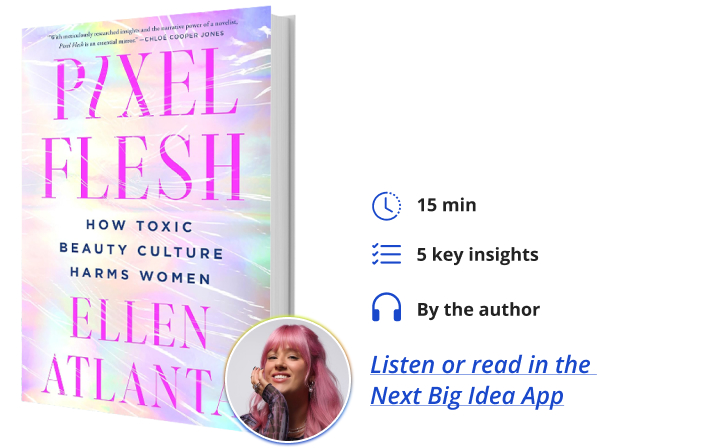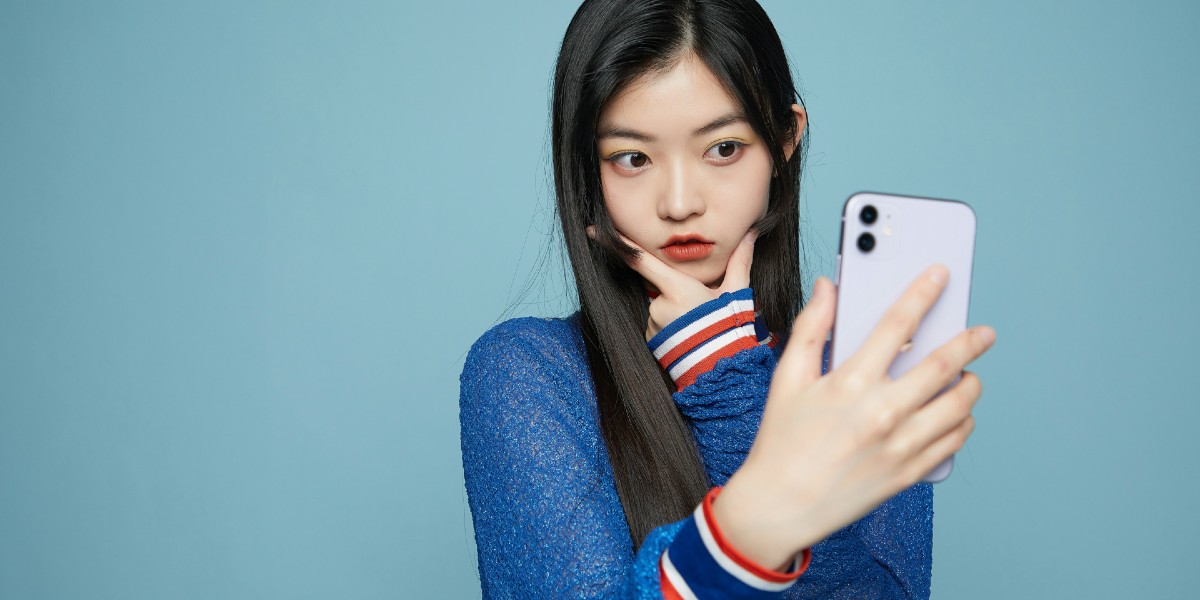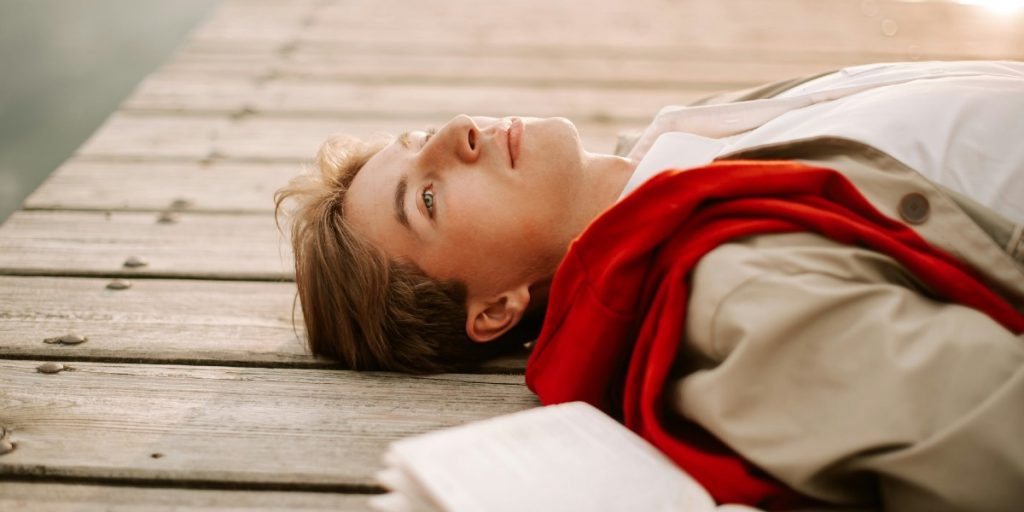Ellen Atlanta is a writer and brand consultant specializing in Gen-Z and millennial culture. She has worked in the beauty industry for almost a decade and was a founding editor of Dazed Beauty and consultant for industry heavyweights such as BeautyCon, Estee Lauder, Milk Makeup, and The Unseen Beauty. With her focus on female empowerment, Ellen departed from the beauty industry in 2019 to become a founding member of both The Stack World and The Restless Network, reimagining social media platforms and creating better digital spaces for women and marginalized genders.
Below, Ellen shares five key insights from her new book, Pixel Flesh: How Toxic Beauty Culture Harms Women. Listen to the audio version—read by Ellen herself—in the Next Big Idea App.

1. The digital gaze is upon us.
You might’ve heard of Instagram Face—the term coined by writer Jia Tolentino to describe the phenomenon in which celebrities are beginning to look uncannily alike, with pore-less skin and plump, high cheekbones. They have catlike eyes and long, cartoonish lashes; a small, neat nose and full, lush lips. Their faces and features are increasingly bought and augmented in response to our digital realm, with exaggerated features designed to appeal on screen, to fit perfectly in pixels, and to stand out when put in a box. From Kylie Jenner to Kim Kardashian, Bella Hadid to Emily Ratajkowski, we’re seeing the normalization of injectable procedures, cosmetic surgery, photo editing, and filter use to achieve a look that works in the digital for the professionally beautiful.
But it has gone so much further than that. Young girls are now filtering existence through a digital gaze, living for a dimension beyond the physical world. Already under immense pressure from beauty standards, young girls are feeling the compounded weight of existing in multiple realities and needing to be perfect in them all.
In our digital age, women and girls are subjected to unprecedented levels of scrutiny. Teenage girls are the most likely of any demographic to take and post selfies, using filters to edit their appearance. Meta’s own research concluded that Instagram was toxic for girls, making them feel worse about their bodies, while 83 percent of women say social media negatively impacts their self-esteem. According to the Harley Medical Group, women are twice as likely as men to feel unhappy with how they look. Meanwhile, 52 percent of 11 to 21-year-olds feel the need to look perfect—an increase of almost 10 percent since 2016. We are currently experiencing an epidemic of perfectionism in young women, with almost half of secondary school girls considering some form of surgical intervention to change their looks. In the latest report by the CDC, the U.S. national public health agency, 57 percent of teen girls in America felt “persistently sad or hopeless” in 2021—an almost 60 percent increase in the last decade. Depression rates are twice as high among girls as among boys, with social media thought to be a major contributing factor. Since the advent of digital platforms, the incidences of eating disorders and body dysmorphia in the U.S. and the U.K. have risen by around 30 percent.
It’s an issue that transcends fame, fortune, and follower count. At dinner one day, I sat across from a 21-year-old who told me that, as a result of growing up online, every living moment is an out-of-body experience, like a never-ending Big Brother experiment: “Even when I’m crying, I’m wondering if my tears are falling beautifully or if my mascara is running in an aesthetic way,” she says. “Just talking to you right now, I’m holding my stomach in and arching my back, I’m thinking about how I would look if someone were to capture me. If they were to take a photo of this moment, would I be beautiful enough?”
According to research by Dr. Claire Pescott, girls as young as 10 describe this surveillance, this feeling of being watched, of needing to be perfect and flawless at all times. Their male peers are unaware of its presence. “I wish I was wearing a filter right now,” one 10-year-old girl had said.
This rise in perfectionism among young girls translates into a greater desire for cosmetic enhancements. Nose jobs are the most popular surgery in teens, likely because it’s the feature most distorted by a digital lens. Researchers found that the close-up perspective of selfies, paired with a phone camera’s typically wider lens, means that noses in selfies appear up to 30 percent wider than they do in real life. I’ve lost count of the number of young women and girls I have met who are planning cosmetic surgeries simply to look good in photos.
At a charity, I work with girls aged eight through 14, and they told me that they don’t go outside after school anymore because they don’t want people to see their real faces more than they already “have to.”
2. Are we facing the death of teenage girlhood?
On TikTok, a video of a young girl went viral. It opens with: “Here’s some things I do to slow down the aging process as a fourteen-year-old. I started doing most of these things at twelve.” Her routine includes taking two apple cider vinegar tablets a day, using two face masks a day, and applying retinol twice a day. She pays attention to the skin on her neck as “one of the main things that ages.” Her lengthy regimen also includes “three fingers’ worth” of sunscreen and green tea with honey to tackle inflammation. She adds that on long road trips, she tapes construction paper to her parents’ car window to block UV rays.
So much of our disgust for women’s bodies is tied to their natural function, whether that’s body hair, stretch marks, menstruation, or weight fluctuation—all key markers of puberty and the ascent into womanhood. To go through puberty while growing up online, in this glossy space, is to face a horrifying discovery as you watch your body deviate from the standard in real-time.
“With the increasing fixation on appearance and fetishization of youth, many young women and girls are being robbed of a time meant for experience, freedom, and experimentation.”
The number of 18 to 24-year-old U.S. women who consider anti-aging important rose by 30 percent from 2012 to 2018. The fixation young women and girls have with their appearance in our hyper-visual digital culture is causing teenagers to adopt the routines, fears, and concerns previously reserved for those in their mid-life and beyond. Convincing teenage girls and young women that they must expend valuable energy and resources to stop the passage of time is a genius move on behalf of a patriarchy that wants to keep us hopelessly occupied, physically and psychologically.
While we’re all fighting to immortalize our faces in their teen image, what we’re facing is the death of teenage girlhood, as the bridge between childhood and adulthood gets shorter and shorter. With the increasing fixation on appearance and fetishization of youth, many young women and girls are being robbed of a time meant for experience, freedom, and experimentation. Instead of pushing boundaries, taking risks, learning who we are, what we like, what we’re capable of, and what we demand, we’re learning how much acid will burn our skin and how many milliliters of poison we can safely inject into our heads.
3. This intensification of the beauty standard is fueling a new class divide.
There is a halo effect around beauty. Being beautiful or attractive can unlock opportunities, open doors, and improve how you’re treated. In an increasingly visual digital world, where image is everything and adherence is rewarded with platform and status, beauty as a currency, as a tool for social mobility, is only gaining value. Thanks to social media, selfies, and Zoom calls, our faces and bodies are always front and center and have become something to invest in. The more beauty you possess, the more wealth you can accumulate.
In the age of technology, beauty standards are creating a higher-than-ever beauty tax. Women are expected to undergo not only the usual roster of “maintenance” treatments (hair, nails, eyebrows, lashes, teeth) but also “treatments” like injectables and surgeries. Those who are celebrated for their beauty both online and offline are increasingly people who have undergone various surgeries and treatments.
“As the price tag of beauty increases, people are putting themselves at risk financially to participate.”
The pursuit of beauty is entirely rational. It often promises safety, increased credibility, status, power, followers, better health, positive employment outcomes, opportunity, and respect—especially for women. As a result, we are given little choice but to chase this elusive quality in order to get a better slice of the world, or even to simply feel human.
As the price tag of beauty increases, people are putting themselves at risk financially to participate. An article in Refinery29 detailed how women are racking up thousands in credit card debt to get Botox and filler. The pressures leveled against women to retain and maintain the perfect face, resist aging, remove body hair, and groom themselves to perfection mean that beauty treatments are often paid for in place of other “essential” items.
Our perception of ugliness often intertwines with disability, queer identity, race, and poverty. Those who are already marginalized are most at risk from ostracization on the basis of beauty. The result is a new beauty class system in which there are those who can afford to participate and those who cannot.
4. Social media is fueling the fragmentation of our bodies.
Ask any woman or girl and she will produce, with ease, a list of her own body parts that are defective. She may be able to tell you that some parts of herself are “okay” and perhaps name one or two that she likes, but this is rare. One study that stood out to me showed that when asked to describe their bodies, women tend to break themselves down into a series of pull-apart components that need fixing.
Men, on the other hand, view their bodies as single units, as whole, holistic entities. Perhaps most importantly, men think much more about their bodies’ capabilities. Every single man asked to describe their body in a study by the University of Sussex talked about it in terms of what it could do. Not a single woman did. Instead, the women in the study assessed the value of their body solely as a decorative object, based only on aesthetic value. The fragmentation extended past their physical selves and into their sentient selves.
“Our faces, in ever-finer fragments, are being intricately rebuilt in the image of the ideal.”
The rise of social media has exacerbated this issue. Studies show that girls often choose profile pictures that focus on their faces or upper torsos, while boys prefer full-body shots. This suggests that boys are allowed to present themselves as whole beings, whereas girls feel compelled to highlight specific parts of their appearance for scrutiny and validation.
We post images that break ourselves down into components, perfecting images of ever-closer crops. We post a pair of lips, collarbones, breasts, a ribcage, a bum—treating our body parts like display objects rather than acknowledging ourselves as whole. By capturing specific separate body parts, we intensify the beauty standard applied to that particular piece of ourselves, creating the blueprint for how we “should” look. Beauty becomes a jigsaw puzzle of perfect pieces, all of which must come together.
I met girls in their twenties on their third nose job, focusing on ever finer details of their face: perfecting their nostrils, columella, alar rim, and infratip lobule. I find myself fixating on my nasolabial folds and my buccal fat—words I didn’t have knowledge of before the internet brought them to my attention. Our faces, in ever-finer fragments, are being intricately rebuilt in the image of the ideal. In doing so, there’s also this ancestral fragmentation, erasing millennia of cultural history from our faces and bodies in favor of a homogenized beauty standard.
5. Sorority is self-care.
The future of feminism lies in collective action. My belief, above all, is that we need to think and act as a collective sisterhood—and not in the clichéd Instagram quote-post kind of way—but in a real, tangible, community-driven way. It is vital for our survival. In a reality that fortifies isolation and individualism, in which your community is simultaneously everyone and no one, we need to come together to fight back. We, as an assembly, need to commit to creating circles that nurture collective well-being. And I mean true wellbeing, not self-loathing disguised as self-care.
In my months of researching and interviewing, I realized that when we come together, we realize that we don’t need beauty or technology as a new form of spirituality; we don’t need to spend money, harm ourselves, starve, or fixate on our features. What we need is each other: touch, connection, affirmation, and support. We, as a collective, have the power to create a beautiful future.
The issue is systemic and structural. The intersecting forces of the patriarchy, capitalism, racism, ableism, ageism, classism, colorism, and fatphobia are directly responsible for our experience of beauty culture. They won’t be neutralized overnight, but we have immense power within our communities, both online and offline.
We need to combine the collectivism from second-wave feminism of the 1960s and 70s with the individual responsibility of modern movements. Instead of channeling your focus into creating a shrine for the self, ask how you can act in service of the sisterhood. We have more in common than we realize. We share more suffering than we know, and we win and lose together. There is a mythological girl reborn in all of us, who will continue to reincarnate until we create tangible change. Our intergenerational goal should be, as bell hooks says, to “rebirth the girl within” into a world where she is eternally worthy, not forever young.
To listen to the audio version read by author Ellen Atlanta, download the Next Big Idea App today:
































